Loaded Potato Salad made with your favorite baked potato toppings in convenient salad form! It’s Guaranteed to be a potluck favorite!
This Loaded Potato Salad is hands down my favorite potato salad and will steal the show at every potluck, picnic, game day or backyard barbecue! It’s loaded with tender potatoes, crispy bacon, sharp cheddar and fresh chives enveloped in a creamy, sour-cream laced ranch dressing. It’s portable, easy to make, make ahead friendly, easy to double/triple for a large crowd, tastes fabulous warm, or cold and compliments any meal. With one bite, this Loaded Potato Salad will be your favorite potluck side dish too!
For more potato recipe, our readers love Traditional Potato Salad, German Potato Salad, Potatoes Au Gratin with Bacon, Company Mashed Potatoes, and Twice Baked Potatoes.
Loaded Potato Salad Recipe Video

pin this recipe to save for later
the best potato salad RECIPE
No barbecue, pool party, or picnic is complete without a giant bowl of potato salad – and this recipe is the best in my humble opinion. After all, what’s not perfection about tender, creamy potatoes fully loaded with tons of cheese, bacon and green onions swaddled in homemade ranch dressing. It’s the best combination of crispy, creamy, and comforting that all come together to create the best potato salad.
Why this recipe works:
- Crowd pleaser: Even people who don’t normally like potato salad swoon over this recipe. What’s not to love?! It’s like a comforting baked potato served alongside a steak dinner loaded with all things right in the world. Everyone will be begging you for the recipe!
- Easy: This potato salad recipe serves a lot of people without a lot of effort. If you can boil potatoes and cook bacon, you can make this recipe! It’s also equally as easy to double or triple for a large crowd.
- Flavorful: This recipe is made with humble ingredients but is exploding with flavor thanks to the homemade ranch dressing. The mayo and sour cream-based dressing is dressed with dill, parsley, chives, onion powder and garlic powder to create an intoxicating dressing that will have you licking the bowl!
- Foolproof: It avoids the common pitfalls of many recipes to deliver the best possible potato salad. This recipe includes the proper cooking techniques combined with the best ingredients and proportions to bring you the best potato salad recipe. Your potatoes won’t fall apart, the salad isn’t watery, the bacon doesn’t get lost and it’ not bland or one note. Instead, this recipe is mega creamy, exploding with flavor and will have everyone begging for the recipe.
- Versatile: This potato salad recipe compliments any protein, anytime, anywhere 365 days a year. This Loaded Potato Salad is delicious with grilled proteins such as grilled chicken, steak or pork in the summer but it’s equally as crowd pleasing on Game Day, Thanksgiving, Christmas, Easter, or any night of the week!
- Make ahead or don’t: This spin on classic potato salad is make-ahead friendly and temperature flexible for a stress-free hit at every holiday and potluck! This Loaded Potato Salad can be made ahead of time and chilled for hours before serving OR whip it up and served immediately at room temperature.
- Portable: Serve chilled or at room temperature: This potato salad is delicious chilled, room temperature or even warmed so you can have confidence bringing it to any gathering and know it will be a hit! No worrying about keeping your potluck side cold!
WHERE DOES POTATO SALAD COME FROM?
If you find food history fascinating like me, read on, otherwise skip to the next secion ;).
The rise of potatoes
It’s hard to imagine a time when potatoes weren’t a staple at every dining table, but they weren’t popularized in America until the late 1800s! The potato was cultivated in modern-day southern Peru and northwestern Bolivia between 8,000 and 5,000 BC. The potato was brought to Europe in the 1500s by explorers but didn’t arrive in America until 1621 when the Governor of Bermuda sent two large cedar chests of potatoes and other vegetables to the Governor of Virginia at Jamestown. The Colonists had never seen a potato before and many refused to eat the new distrusted crop. The cultivation of potatoes slowly spread across the country but most Americans considered the potato as food for animals only. Finally, in 1872, the Russet Burbank potato was developed by American horticulturist Luther Burbank and the more disease-resistant potato took off.
Making the first Potato Salad
As the popularity of the potato spread, so did its uses. In Germany, potato salad was created as a way of using up leftover roasted or boiled potatoes. In the southern Bavarian region, inexpensive ham or bacon were added, and the drippings were combined with vinegar to make the dressing, this is what we know as German Potato Salad. In northern Germany, most potato salads are mayonnaise-based with the addition of hard-boiled eggs and pickles.
American Potato salad and the addition of mayonnaise
Recipes for potato salad were likely brought to the United States when German settlers immigrated to the US in the early 19th century, but it’s unclear exactly when mayonnaise was added. We do know that mayonnaise sold in jars began selling commercially in Philadelphia in 1907 when Amelia Schlorer decided to start selling her own mayonnaise recipe in the family grocery store. It was an instant success with local customers and eventually grew into the Schlorer Delicatessen Company. Around the same time, Richard Hellmann’s began selling his wife’s recipe at a delicatessen in New York that become extremely popular and in 1926 became trademarked as Hellmann’s Blue-Ribbon Mayonnaise.
As America’s obsession with mayonnaise grew, they were quick to create a variation of the European-style potato salad to include mayonnaise, pickles, celery and hard-boiled eggs. Today, we are still blessed with classic potato salad as well as all sorts of variations, including this Loaded Potato Salad recipe!
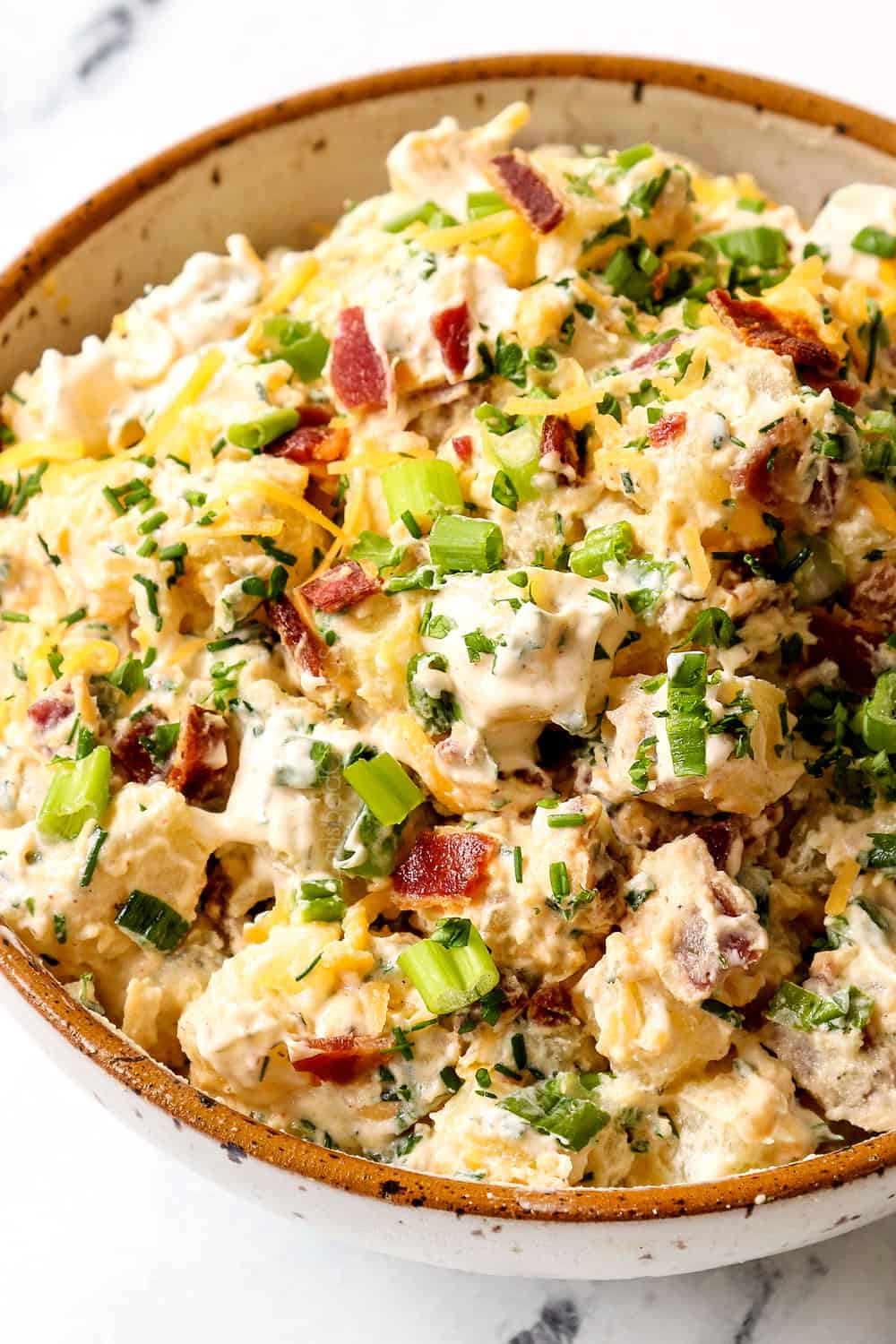
WHAT ARE THE BEST POTATOES FOR POTATO SALAD?
In order to make the BEST Potato Salad, you need to choose the right potatoes for the job. Potatoes based on texture can be categorized into 3 groups:
- Waxy potatoes: these thin-skinned potatoes have the least amount of starch and retain their shape well when boiled. Thin skins also mean that peeling is optional if you’re short on time or like a more rustic salad. Examples are red, new, or fingerling potatoes. The down side of waxy potatoes is they do not hold flavor of dressings or vinaigrette well.
- In-between potatoes: also known as all-purpose potatoes, these potatoes have more starch than waxy potatoes, but will generally work well in most potato dishes, including potato salad. White and Yukon Golds are the most popular potatoes in this group, and are reliable in-between potatoes to always have around. These potatoes hold both their textures and flavors from dressings well.
- Starchy potatoes: like Russets should be avoided for potato salad. They are starchy, thick-skinned and will fall apart during the cooking process. Instead, Russet potatoes are ideal for mashed potatoes.
For the Best potato salad recipe, use in-between potatoes such as Yukon gold potatoes. Yukon Golds boast a delicious buttery flavor, are a little sweet, creamy, hold their shape after cooking, have thinner skin so they’re easy to peel after boiling and won’t fall apart or become mushy. They also absorb the dressing better than waxy potatoes resulting in tastier potatoes through and through.
INGREDIENTS IN loaded POTATO SALAD
Classic potato salad is made by tossing potatoes with a mayo/mustard dressing, pickles, celery and hard-boiled eggs. This Loaded Potato Salad skips the traditional add-ins and is dressed like a baked potato with a mayo/sour cream ranch dressing, cheese, bacon and green onions. Here’s what you’ll need:
For the potato salad
- Yukon gold potatoes: try and select potatoes of uniform size so they will cook evenly.
- Bacon: the more the better! Please use thick cut bacon so the bacon doesn’t get lost and retains its meaty texture when enveloped in the dressing. You can chop the bacon and then cook it or cook it in slices.
- Cheddar: sharp cheddar is the quintessential cheese for loaded baked potatoes. Use quality, freshly grated cheddar and not pre-shredded for the best flavor and texture. I suggest grating the cheese on the smallest holes of the cheese grater for the best cheese to salad ratio.
- Green onions: add a subtle onion flavor with bright, crisp greenness. You’ll want ½ cup chopped green onions which is about 1 bunch.
For the dressing
- Mayonnaise: provides the creamy base of the dressing and binds all of the ingredients together. Even if you don’t like mayo, I don’t suggest skipping because it prevents the dressing ingredients from separating – and your dressing will not taste like mayo! Please use real mayonnaise and not miracle whip. You may also use avocado based mayo for a healthier spin.
- Sour cream: adds a delightful tanginess to the dressing just like the topping of a baked potato! Fat-free sour cream can be used but remember, fat equals creaminess and flavor so adjust your expectations accordingly.
- Apple cider vinegar: just a dash to enliven the flavors but it won’t make your salad tangy. I prefer apple cider vinegar for its mellow, fruity flavor but if you only have white vinegar, I suggest starting with a little less and adding more to taste if needed.
- Mustard: Dijon mustards adds a subtle depth of flavor but don’t worry, your potato salad won’t taste like mustard!
- Homemade ranch seasoning: a combination of parsley, dill, chives, garlic powder, onion powder, salt and pepper create the fabulous ranch flavor profile that’s flavorful but not overwhelming. I’ve also included substitutes to use dried herbs instead of fresh.
POTATO SALAD recipe VARIATIONS
This potato salad recipe can be a blank canvas for all sorts of add-ins as long as you keep the ratio of dressing to ingredients the same, otherwise, you’ll lose some of the creaminess. Here are a few ideas:
- Use different potatoes: I’m partial to Yukon Golds, but use whatever potato you like best for potato salad!
- Use roasted potatoes: chop potatoes into ½-1-inch cubes, toss in olive oil and roast in a single layer at 400 degrees F for 30-40 minutes.
- Use baked potatoes: wash, dry, lightly oil whole potatoes and prick each one with a fork a few times. Bake in a single layer on a baking sheet at 400 degrees F 45-60 minutes OR just until fork tender (larger potatoes may take 75 minutes), turning the potatoes once or twice during baking.
- Swap cheese: use your favorite or mix and match! Try Gouda, Colby, Pepper Jack, White cheddar, Havarti, feta, Parmesan or blue cheese. You can also cube the cheese instead of shred it.
- Use different vinegar: if you don’t have apple cider vinegar on hand, it can be swapped for white vinegar or red wine vinegar instead, but start with less and add more to taste.
- Use different mustard: if you don’t have Dijon mustard, swap it for any mustard such as regular yellow mustard, spicy brown mustard, French, whole grain, etc.
- Add chili: who doesn’t love chili smothered baked potatoes? Try mixing in homemade chili or a can of your favorite chili beans. Consider serving warm or room temp.
- Add veggies: celery, bell peppers, petite peas, broccoli, corn, mushrooms, tomatoes, etc. can all be added. Remember, to keep keep the dressing to add-in ratio the same!
- Add pickles or relish: tangy pickles and relish are a nod to traditional potato salad. Keep in mind they are strong and will drastically change the flavor profile of Loaded Potato Salad.
- Add eggs: hard boiled eggs add texture and creaminess.
- Add red onion: swap the green onions for red onions. You may want to tame the red onions to make sure they don’t overpower the salad by adding the chopped onions to a sieve and placing the sieve in cold water for 10 minutes. Make sure to dry the onions very well afterwards.
- Other add-ins: mix and match from, Kalamata olives, avocados, artichokes, radishes, sundried tomatoes, etc.
- Use different seasonings: you can season the potato salad with virtually any spice blend such as Italian seasonings, Cajun seasoning, Old Bay seasoning, Everything Bagel seasoning, curry, etc.
- Swap herbs: as written, the herbs combine to create the blessed flavor of homemade ranch. Feel free to experiment, however, with other herbs such as cilantro and tarragon. Start with ½ tablespoon and add to taste.
- Dressing alternatives: add pesto, horseradish, buffalo hot sauce, harissa, or salsa to the dressing along with the appropriate seasonings to mix up the flavor.
- Buffalo Potato Salad: add some buffalo hot sauce to the dressing, chopped celery to the salad and swap some of the cheddar for blue cheese.
- Greek Potato Salad: replace some of the cheese with feta, add chopped celery, Kalamata olives, sun-dried tomatoes, feta, roasted red bell peppers, etc.
Dietary Swaps for Potato Salad
- Omit the mayo: if you really can’t stomach mayonnaise, use a vegan mayo, all sour cream or full-fat plain Greek yogurt instead.
- Make it gluten free: all of the ingredient in this potato salad recipe are gluten free. In rare cases mayonnaise may contain gluten, so make sure to double check the packaging.
- Make it dairy free: omit the cheese and swap the sour cream for your favorite dairy free/vegan sour cream substitute. You may also swap the sour cream for additional mayonnaise but it won’t taste as light. Mayonnaise is dairy free but not vegan as it is made with egg yolks, vinegar and seasonings.
- Make it vegetarian: use vegan bacon (see below).
- Make it vegan: for vegan or plant-based, omit the cheese or use dairy-free cheese, use vegan mayo, vegan sour cream or yogurt and vegan bacon.
- Use vegan bacon: vegan bacon or vegan bacon bits might sound odd, but when done right can be crispy, smoky and work great as a bacon alternative to bacon. There are several vegan bacon options out there made from either tofu (soy), tempeh, eggplant, coconut, or mushrooms. If you’re looking to make your own vegan bacon, check out this post by Love and Lemons – it almost has me converted, almost.

How can I make healthier potato salad?
This Loaded Potato Salad is meant to be an occasional party splurge and so worth the calories. Still, if you would like to make it lighter, here are some options:
- Use olive oil mayo. Instead of using regular mayo, try using mayonnaise made with olive oil (it will say right on the label). Olive oil mayo traditionally has half the fat of regular mayonnaise but is still super creamy and tastes better than reduced fat mayo in my opinion. Of course, you can also use traditional nonfat and reduced fat mayo.
- Use nonfat sour cream. Nonfat sour cream won’t be as creamy but will still work in this recipe because it’s being whisked with the mayonnaise.
- Sub yogurt for sour cream. You may also use non-fat Greek yogurt instead.
- Use less cheese. By using half of the cheese, you save half of the calories!
- Use turkey bacon. Turkey bacon has about ⅓ less fat than regular bacon, including less “bad’ fats.” It also has a lower glycemic index. Alternatively, use vegan bacon.
- Use vegan bacon. A 2-ounce serving of vegan bacon ranges from .5 grams of fat to 4.5 grams of fat compared to real bacons 22 grams, which makes it great lighter alternative.
How to Cook Potatoes for Potato Salad
Cooking potatoes correctly for potato salad is crucial so they are flavorful, creamy and tender and don’t fall apart. Follow these tips for success for perfectly cooked potatoes every time:
- Use uniform potatoes. When selecting the potatoes, hand-pick them as opposed to grabbing a bag so you can select potatoes of similar size so they cook in the same amount of time.
- Scrub those potatoes before you boil them. This is especially important because the potatoes are quartered before cooking – you don’t water dirty water permeating the potatoes.
- Quarter, don’t chop the potatoes. While many recipes call for cubing the potatoes before cooking, I prefer to quarter them. This serves two purposes 1) maintains more of their flavor and natural sweetness, 2) promotes a better texture.
- Start potatoes in cold water. You want to add your quartered potatoes to cold water before bringing the water to a boil. If you add the potatoes to boiling water, the outsides will cook immediately and be mushy by the times the insides are tender. By bringing the potatoes to a boil with the water, they cook evenly to perfectly melt in your mouth consistency.
- Salt the cooking water. It’s important to add a generous amount of salt to the cooking water. This instantly infuses the potatoes with flavor from the inside out that simply isn’t achievable any other way. And no, this won’t make the potatoes salty!
- Salt the cooking water after you add the potatoes. If you forget and add the salt with the potatoes, it’s not the end of the world, but I like to salt the water once it’s boiling for two reasons: 1) adding salt to water before it’s boiling will make the water take longer to come to a boil because salt raises the boiling point; 2) the boiling water will agitate and dissolve the salt quickly and evenly.
- Simmer, don’t boil the potatoes. Cover the pot of potatoes with the lid to help bring them to a boil (otherwise it takes forever), then remove the lid and reduce the heat to a simmer. A simmer will cook the potatoes just as quickly as a boil and they won’t jump all over the pot.
- Don’t overcook the potatoes. The potatoes are done when they are barely fork tender, meaning you can push a fork through the center without any force. No fancy tips on getting this right, especially as cooking times will vary, so just test your potatoes often.
- Use an ice bath. An ice bath is a secret weapon for perfectly cooked potatoes. It instantly cools down the potatoes so they stay perfectly fork tender, otherwise, if you don’t use an ice bath, the potatoes will continue to steam, even if you rinse them in cold water, and you’ll end up with over-cooked, crumbling potatoes.
- Peel the potatoes after cooking. You can leave the skin on if you wish for more rustic potato salad, but I prefer to remove the skins in this recipe. After the potatoes are cooked and cooled, peel the skin. The skin is left on while cooking to help protect the potatoes and keep them in tact but more importantly to me, peeling the potatoes after they are cooked is a breeze, the skin strips right off!
HOW TO MAKE POTATO SALAD
You are going to love how easy this Loaded Potato Salad is to make – let’s get cooking! (Full recipe with measurements at the bottom of the post.)
- Step 1: Cook the potatoes. Add potatoes to a large pot and fill with water to about 1-inch above potatoes. Bring to a boil and then season with 1 ½ tablespoons salt. Reduce heat to a simmer and continue to cook for 10-15 minutes or until potatoes are easily pierced with a fork. Drain potatoes and transfer to a water bath. Once cool, peel and cube potatoes.
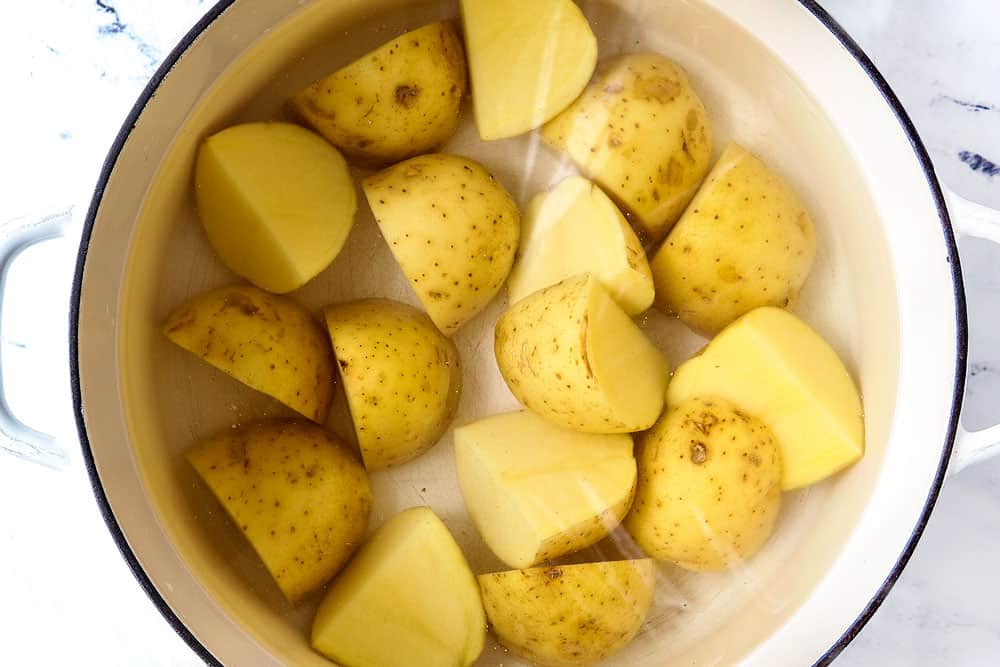
- Step 2: Cook the bacon. While the potatoes are simmering, cook the bacon. To cook bacon, start it in a large, cold/unheated cast iron skillet without any oil. Working in batches, lay the strips of bacon in a single layer. Increase heat to medium and cook until browned and crispy, flipping occasionally. Drain on a paper towel lined plate.
- Step 3: Make the dressing. Whisk together all of Dressing ingredients together in a medium bowl; set aside.
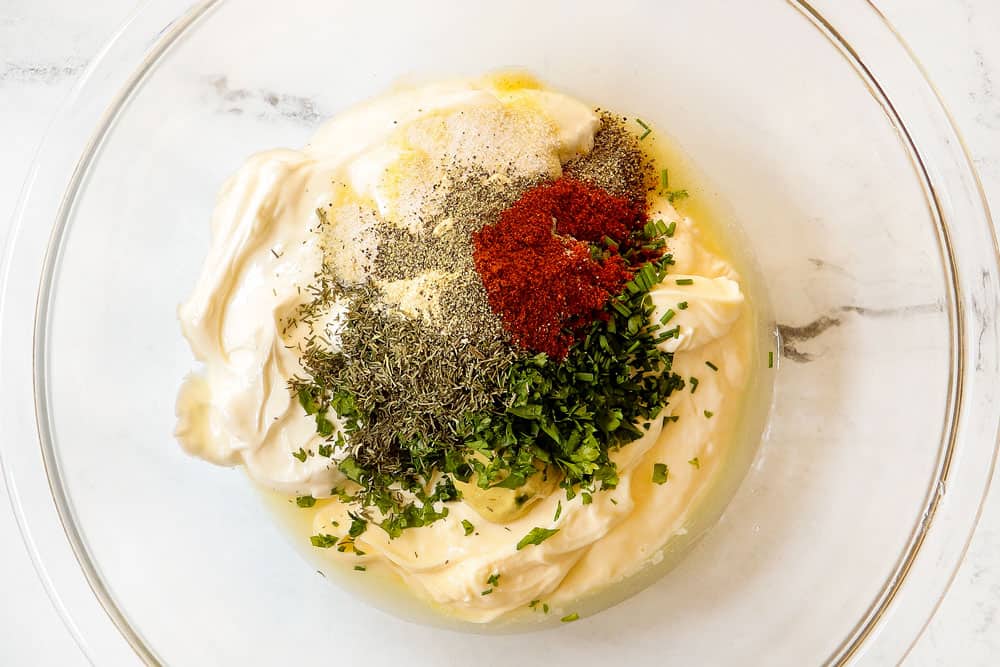
- Step 4: Assemble. Add bacon, cheese, green onions and the homemade dressing to the COOLED potatoes. Stir until evenly coated.
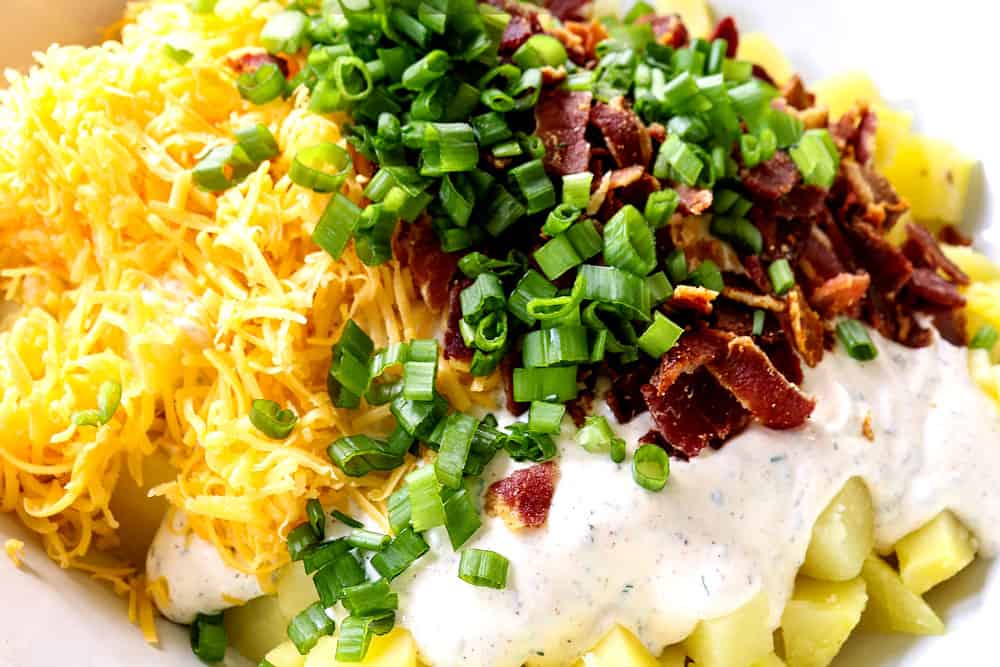
- Step 5: Serve. Serve the potato salad immediately or refrigerate until ready to serve. If the salad seems a little dry, stir in additional sour cream/mayo or a drizzle of olive oil. This potato salad can be served chilled, room temperature or warm.
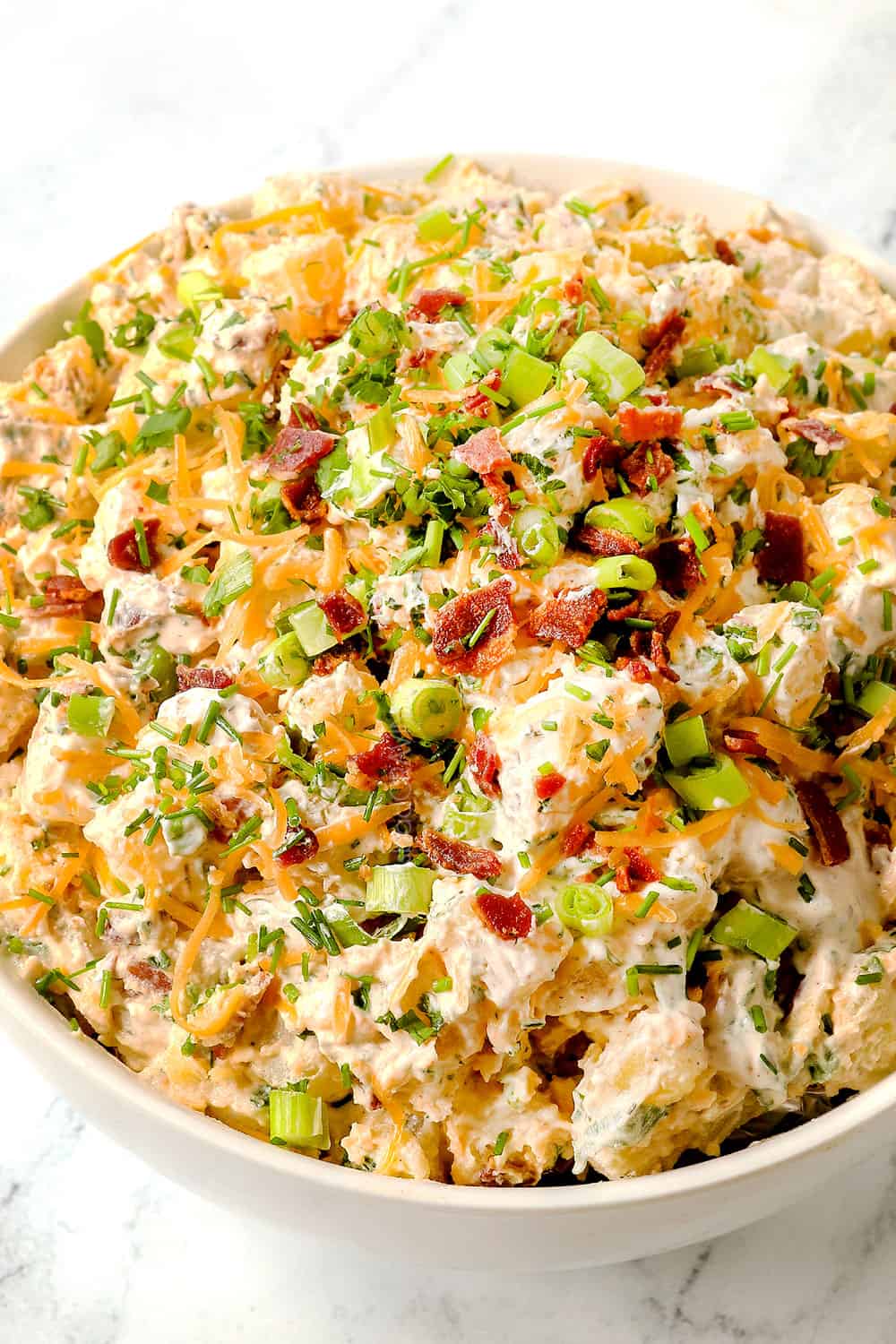
Can I cook the bacon in the oven?
Absolutely! Preheat the oven to 400 degrees F and line a large rimmed baking sheet with aluminum foil. Top with a wire baking rack and lightly spray it with cooking spray. Line the bacon strips on the baking rack in a single layer and bake for 15-25 minutes, until crispy. The thicker the bacon, the longer it will take to cook.
HOW TO AVOID A “WATERY” POTATO SALAD
A watery potato salad is likely caused by mixing the potatoes with the dressing while they’re still hot, which causes the potatoes to sweat and release water. The warm potatoes will also melt the dressing which makes it more watery/oily. The good news is, it’s very easy to avoid a watery potato salad by following these simple rules:
- Use an ice bath to cool the potatoes. An ice bath will quickly cool the potatoes through and through as opposed to just rinsing them which only cools the surface of the potatoes.
- Thoroughly drain the potatoes. The boiled potatoes will be full of water so make sure you sufficiently drain them in a colander after they have been submerged in the ice bath.
- Chill the potato salad before serving. Chilling the potato salad in the refrigerator for at least an hour will thicken the dressing and help it set.
IS this potato salad served hot or cold?
Loaded Potato Salad can be served chilled, room temperature or warmed. I have tried it all three ways and while each is delicious, I am partial to room temperature or warmed. Room temperature works out well because you don’t have to stress about the salad staying chilled when taking it to a potluck. Just let the salad come to room temperature for about 30 minutes before serving
To warm potato salad
I tried the potato salad warm when I had leftovers – and they were amazing! To warm, transfer the salad to a large Dutch oven and heat over low to medium-low heat, stirring gently and occasionally (don’t let it simmer!). Alternatively, transfer to a large baking dish, cover with foil and bake at 350 degrees for 10-15 minutes. You can also microwave leftovers for 30 seconds or so just until warm but not hot.
How long can potato salad sit out?
Food Safety Reminder
It’s important to not leave potato salad at room temperature for more than 2 hours or it can grow bacteria and cause food poisoning. Potato salad becomes prone to bacteria when its temperature ranges between 40 to 140 degrees Fahrenheit for an extended length of time. The USDA recommends that “if the potato salad was held in excess of 41°F for over two hours, then discard.”
If you plan to serve potato salad at an outdoor gathering where it’s not going to be served until later, keep it in the refrigerator or cooler. To keep potato salad cold while serving for an extended period of time, you can place it in a large bowl filled with ice.
After 2 hours, toss out potato salad that is not stored properly or that has sat outside or at room temperature for 2 hours or more.
CAN I MAKE POTATO SALAD AHEAD OF TIME?
Yes, Loaded Potato Salad is great to make 24 hours ahead of time or just prep the ingredients ahead of time. Here’s how:
- Make entire salad: make the potato salad the night before serving but HOLD the bacon. Store the potato salad in an airtight container in the refrigerator and refrigerate the bacon separately or cook it up right before you serve to keep it extra crispy.
- Cook potatoes: alternatively, you can cook the potatoes ahead of time and keep them in the fridge. Potatoes, however, will turn brown and start to oxidize once cut, so add lemon juice or white wine vinegar to the boiling water before transferring to the ice bath. Store cooled, drained potatoes in the airtight container in the refrigerator for up to 2 days.
- Cook bacon: cook and crumble, then transfer bacon bits to an airtight container; refrigerate for up to 48 hours before using.
- Make Dressing: whisk all of the dressing ingredients together and store in the refrigerator for up to 48 hours before using.
how LONG CAN I STORE POTATO SALAD IN THE FRIDGE?
Potato salad should be stored in an airtight container in the refrigerator. When properly stored, it’s good for up to 5 days, but at its prime within the first 24 hours. After a day it won’t be as creamy, so I suggest microwaving leftovers for 30 seconds or so and you will be amazed at how their creamy glory is restored!
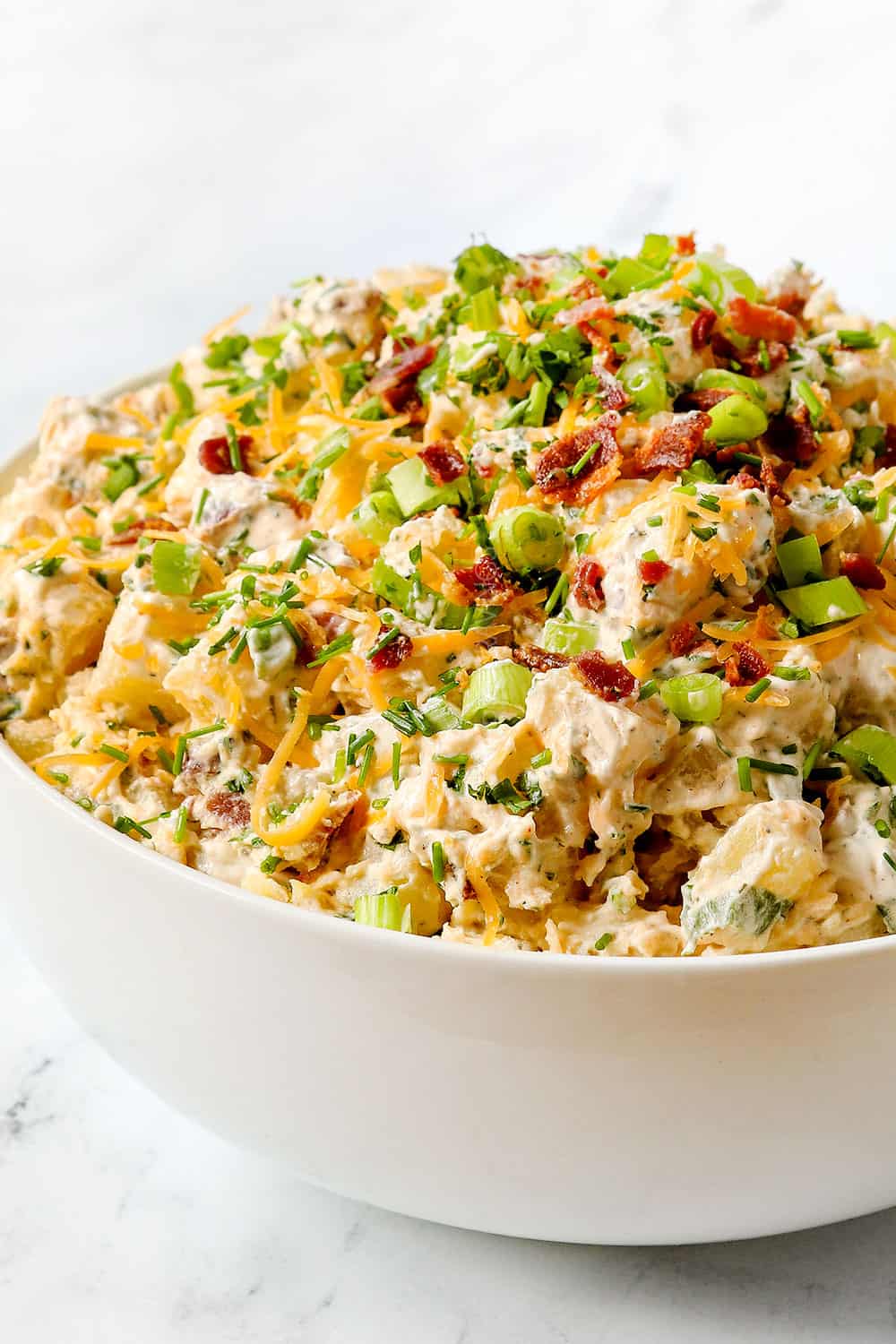
Recipes That Go With Potato Salad
This Loaded Potato Salad is wonderfully versatile – it’s a hit at potlucks, picnics and barbecues alongside all of your favorite cookout foods but it’s equally delicious alongside comforting dinner dishes and it holds its own as part of your holiday spread. Here are just a few recipes potato salad goes with, but the possibilities are endless!
- Serve potato salad alongside your favorite grilled proteins or potluck/cookout main dishes such as: BBQ Grilled Pork Chops, Marinated Flank Steak, Sirloin Steak with Cajun Butter, Grilled Shrimp, Grilled Barbecue Chicken, Barbecue Chicken Kabobs, Steak Kabobs, Buffalo Chicken, Nashville Hot Chicken, Marinated Pork Chops, Best Marinated Grilled Chicken and on and on
- Serve potato salad as part of your potluck spread alongside other favorite side dishes such as: Baked Beans, Italian Tortellini Salad, Greek Pasta Salad, Strawberry Spinach Salad, Cucumber Tomato Salad, Corn Salad, Creamy Grape Salad and Perfect Fruit Salad.
- Serve potato salad as a side to all your favorite sandwiches and burgers such as: BBQ Brisket Sandwiches, BBQ Pulled Pork Sandwiches, French Dips, Philly Cheesesteaks, Italian Beef Sandwiches, Cubano Sandwiches, Best Burgers, and BBQ Burgers.
- Serve potato salad as a side dish for Game day food such as: Beef Brisket, Barbecue Ribs, Honey Buffalo Hot Wings, Lemon Pepper Wings, Honey Buffalo Meatballs and Jalapeno Popper Taquitos.
- Serve potato salad as a side dish to holiday entrees: Roasted Turkey, Brown Sugar Glazed Ham, Honey Baked Ham, Pineapple Glazed Ham, Baked Pork Tenderloin, Mom’s Pot Roast, Balsamic Roast Beef, Chicken Cordon Bleu
Potato salad FAQs
It’s better to boil the potatoes halved or quartered so they cook more evenly and soak up more flavor from the salted water.
No, you don’t need to peel the potatoes, but I always do otherwise the skin can be distracting. I recommend peeling the potatoes after they are cooked. This will give you the best texture.
Bring the potatoes to a boil, then reduce the heat to medium so that the water is still gently bubbling. Cook the potatoes for 10-15 minutes or until they easily pierce with a fork. Immediately drain the potatoes to prevent them from continuing to cook and becoming too soft.
Once the potatoes are cooked and cooled, cube them on the smaller size, closer to ½-inch because this increases the ratio of dressing to potatoes which increases the YUM factor.
I’ve detailed how to cook potatoes in the post, but essentially, the key to perfectly cooked potatoes is: 1) submerge the potatoes in a pot of cold water and then bring them to a boil, 2) immediately reduce to a gentle simmer and 3) transfer cooked potatoes to an ice bath to prevent them from continuing to cook.
Yes, you can boil the potatoes in advance for potato salad, chill in an ice bath then store in an airtight container in the refrigerator until ready to peel and chop. To prevent the potatoes from browning due to oxidation, add vinegar to the boiling water. Use the ratio of one teaspoon to a half gallon of water to achieve the anti-browning effect without any noticeable changes in flavor.
There is no need to rinse the potatoes after boiling if immediately transferring the to an ice bath. If you are not using an ice bath, then it is recommended to rinse the potatoes after boiling to remove excess starch.
Potato salad can separate if the dressing was added when the potatoes were still warm or wet. If the potatoes are warm, the mayonnaise can break and separate. If the potatoes are wet, the water will separate from the dressing. Both of these problems can be avoided by only adding the dressing to the potatoes once completely chilled.
Yes, please do! Potato salad is more flavorful if prepared the day ahead and served the next day so the potatoes have more time to soak up the dressing. If serving the next day, hold the bacon and stir in when serving. That being said, this potato salad is SO good, it is even tasty right away!
24 hours is most I would make potato salad ahead of time or it starts to become less creamy. If your salad is on the drier side, add a drizzle of olive oil or additional mayonnaise or sour cream.
Yes, you can mash your potatoes but then you will end up with cold mashed potatoes! Mashing the potatoes can be a great option, however, if your potatoes are falling apart.
Sadly no. Potatoes do not freeze well, and the mayo and sour cream do not tolerate the cold either. The dressing with separate and the potatoes will break apart and become mushy when thawed. It’s best to enjoy potato salad fresh – or share it with a friend!
LOOKING FOR MORE POTATO RECIPES?
- Slow Cooker Mashed Potatoes
- Potatoes Au Gratin with Bacon
- Roasted Potatoes with Bacon and Parmesan
- Baked Parmesan Fingerling Potato Fries
- Mexican French Fries with Salsa Ketchup
- Chicken Gnocchi Soup
- Twice Baked Potatoes
- Smashed Potatoes
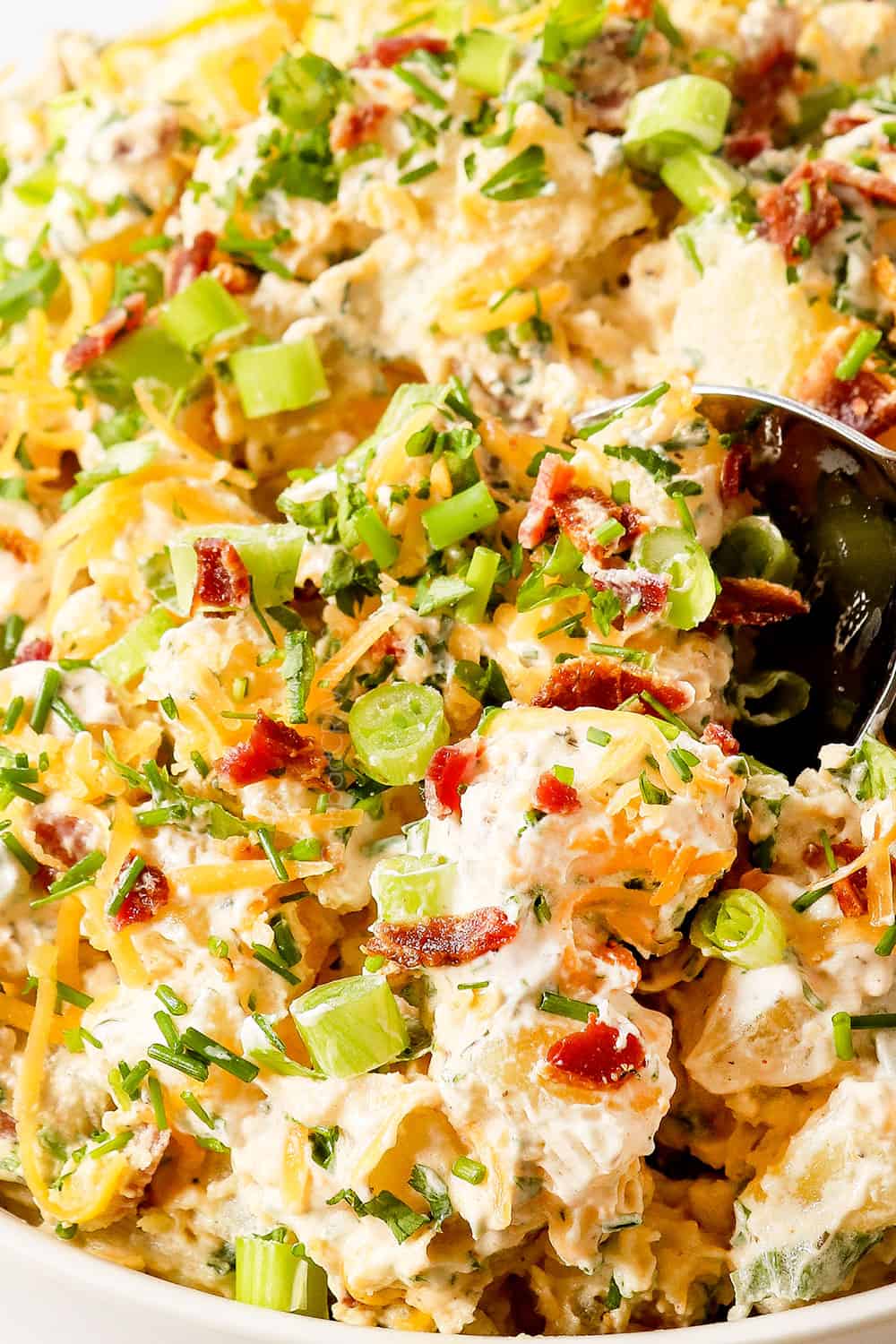

Loaded Potato Salad
Save This Recipe To Your Recipe Box
You can now create an account on our site and save your favorite recipes all in one place!
Ingredients
SALAD
- 3 pounds unpeeled Yukon Gold potatoes, scrubbed, quartered
- 1 1/2 tablespoons salt
- ½ cup chopped green onions (1 bunch)
- 4 ounces freshly shredded sharp cheddar cheese (heaping cup)
- 1 pound thick-cut bacon
DRESSING
- 1 cup mayonnaise
- 1 cup sour cream
- 1 tablespoon apple cider vinegar
- 1 tablespoon Dijon mustard
- 2 tablespoons fresh parsley, minced (or 2 teaspoons dried)
- 1 tablespoon fresh chives, minced (or 1 teaspoon dried)
- 1 tablespoon fresh dill, minced (or 1 teaspoon dried)
- 1 ½ teaspoons garlic powder
- 1 tsp EACH salt, onion powder
- 1/2 tsp EACH pepper, paprika
Instructions
- Cook potatoes: Add quartered potatoes to a large pot and fill with water until it reaches about 1-inch above potatoes. Cover the pot and bring to a boil, then immediately remove the lid and reduce the heat to a simmer. Season the pot with 1 ½ tablespoons salt and continue to gently simmer until potatoes are fork tender, about 10-15 minutes, DO NOT OVERCOOK. (While the potatoes are cooking, cook the bacon and make the dressing.)
- Cool and chop potatoes: Drain potatoes and immediately transfer to an ice bath to cool. Once cool, remove skin and chop into ½-1-inch pieces. Transfer dry, cubed potatoes to a large serving bowl.
- Cook bacon: Working in batches, cook the bacon in a single layer in a large skillet over medium heat until crisp. Remove to a paper toweled lined plate to drain; cool, then crumble.
- Make Dressing: Whisk together all of Dressing ingredients in a medium bowl; set aside.
- Assemble: Add dressing, bacon, cheese and green onions to the COOLED potatoes. Stir until evenly coated.
- Serve: Season with salt and pepper to taste. Serve immediately or refrigerate until ready to serve, best within the first 24 hours. If the salad seems a little dry, stir in additional sour cream/mayo or a drizzle of olive oil. This potato salad can be served chilled, room temperature or warm.
Video
Notes
MAKE ahead
This Loaded Potato Salad is great to make 24 hours ahead of time or just prep the ingredients ahead of time. Here’s how:- Make entire salad: make the potato salad the night before serving but HOLD the bacon. Store the potato salad in an airtight container in the refrigerator and refrigerate the bacon separately or cook it up right before you serve to keep it extra crispy.
- Cook potatoes: alternatively, you can cook the potatoes ahead of time and keep them in the fridge. Potatoes, however, will turn brown and start to oxidize once cut, so add lemon juice or white wine vinegar to the boiling water before transferring to the ice bath. Store cooled, drained potatoes in the airtight container in the refrigerator for up to 2 days.
- OR bake potatoes: you can also bake whole potatoes up to 48 hours in advance before peeling, chopping and combining with the dressing. To bake, wash, dry, lightly oil whole potatoes and prick each one with a fork a few times. Bake in a single layer on a baking sheet for at 400 degrees F 45-60 minutes OR just until fork tender (larger potatoes may take 75 minutes), turning the potatoes once or twice during baking.
- Cook bacon: cook and crumble, then transfer bacon bits to an airtight container; refrigerate for up to 48 hours before using.
- Make Dressing: whisk all of the dressing ingredients together and store in the refrigerator for up to 48 hours before using.
storage
Potato salad should be stored in an airtight container in the refrigerator. When properly stored, it’s good for up to 5 days, but at its prime within the first 24 hours. After a day it won’t be as creamy, so I suggest microwaving leftovers for 30 seconds or so and you will be amazed at how their creamy glory is restored!
Did You Make This Recipe?
Tag @CarlsbadCravings and Use #CarlsbadCravngs
Leave a Review, I Always Love Hearing From You!
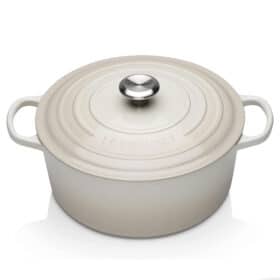

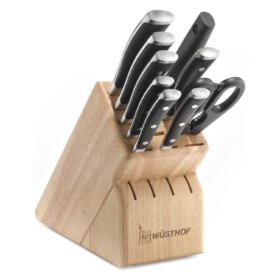
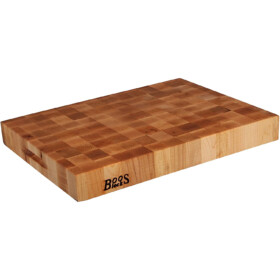
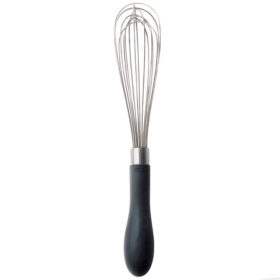
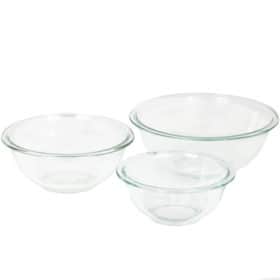
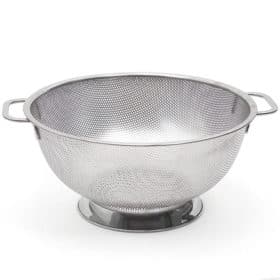
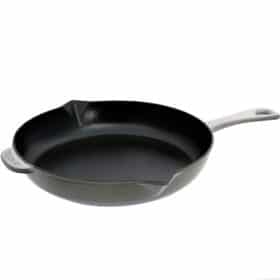



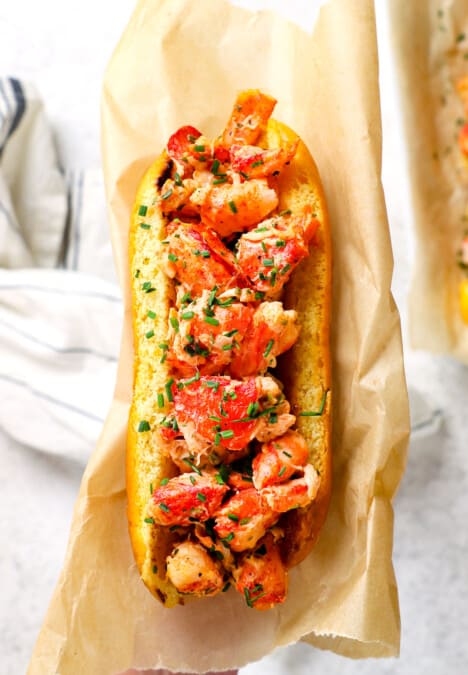
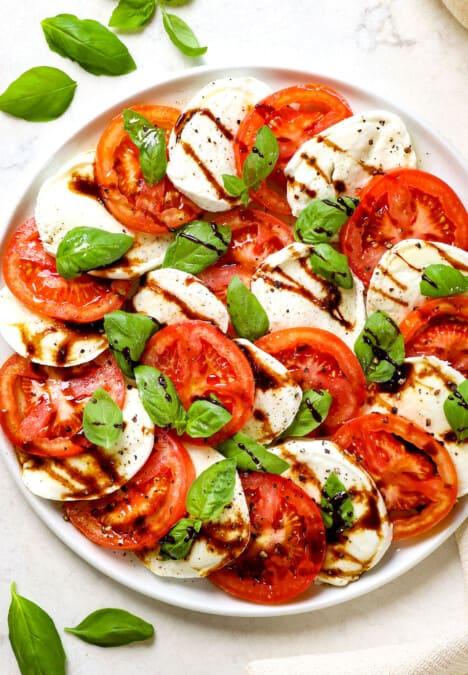
























Dalia says
Made this recipe for our big family 4th of July celebration; to sum it up in one word…”KABOOM”! What a success! My family absolutely loved this salad. Tripled the recipe exactly, using all the fresh herbs; it was incredible! It truly tasted like a “real loaded baked potato”! By family vote…it’s definitely a keeper. Jennifer, you hit it out of the ball park on this one 🙂 Thanks a bunch!
Jen says
Thank you so much for making my day! I’m thrilled this recipe was a huge hit with everyone. PS Opening up my comments to “kaboom” was a highlight 😉
Stephanie says
This is hands down the BEST potato salad I have ever made. We had it last night with smoked brisket and it was amazing. The ranch dressing was so incredibly delicious my 11 yr old stuck her finger in for a taste and said OMG, all I want right now is a plate of french fries to dip in this ranch. LOL, that’s my girl. I liked how creamy it was because I’ve made loaded potato salads before with more sour cream and they were always too gluey. I used all fresh herbs and I’m thrilled to have enough herbs leftover to make another batch of this into a dressing for salad with a whirl in the food processor and a splash of milk.
Jen says
Thanks so much for the awesome review Stephanie, you made my day! I’m thrilled this Loaded Potato Salad is the best you’ve ever made – the ultimate compliment! You can never go wrong with ranch and bacon!
Stephanie says
THIS ranch dressing needs it’s own stand alone post to share how truly awesome it is! The potato salad was amazing, but the ranch is the star of the show! I’ve made this ranch dressing 3 more times (adding a splash of milk to thin since original is thicker for the potato salad) in the past couple weeks for dipping veggies, French fries have taken a swim in it, went on a simple pasta salad that uses ranch, my kids love (bowties, grilled corn, spinach & bacon) I added some blue cheese crumbles to a bowl of dressing for a green salad, I even changed out the herbs to cilantro and added a spoon of adobo sauce from a can of chipotles to use on a taco salad. We are a ranch loving family but hate the taste of the bottled stuff so I only make the ranch made from packets. Until now. There will always be a jar of this in my fridge and I feel good knowing it’s homemade with simple ingredients.
Jen says
Hi Stephanie, sorry for the delayed response – I’ve been on vacation and just catching up 😉 but thanks so much for your awesome comment! I will definitely be making a homemade ranch post using this recipe thanks to your encouragement! I love your variations of adding cilantro, blue cheese and adobo – yum!
Alice Milisits says
I made this salad vegan using vegan Mayo and vegan sour cream and it was fantastic. I was wondering if there was a way to thin the dressing a little to use as a traditional salad dressing. Thanks and this is my fav potato salad!!
Jen says
I’m so pleased it’s a new fav and you were able to make it vegan! You can thin the dressing with a little olive oil and your favorite milk substitute to dressing consistency.
Tiffany Freeman says
Your recipes are ALWAYS the best, but this one is by far my family’s favorite!! You ever considered making a cookbook?? I know about 4 people that would buy one!
Jen says
Thanks Tiffany, I’m so pleased you’re loving my recipes and that this was no exception. No plans for a cookbook yet 😉
Donna DiPaolo says
Yummo
Jen says
Happy you enjoyed!